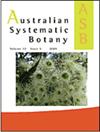金合欢叶和双羽叶表现出当代大陆尺度的环境相关性和进化过渡率异质性
IF 1.6
3区 生物学
Q4 EVOLUTIONARY BIOLOGY
引用次数: 1
摘要
摘要在Acacia中,90%的物种成年后都有耐旱的叶子,其余的物种都有二回羽状的叶子。我们在大陆尺度上测试了树叶类型和35个生物气候变量之间的关系,发现“水分季节性”和“最冷地区的辐射”与树叶类型之间存在显著相关性。双生物种的每个变量的物种平均值都较低,平均生长在稳定的土壤湿度和通常较暗的环境中(夜晚较长,入射辐射较低)。在整个Acacia系统发育中,二回羽状和叶序成叶之间的进化转化表现出不对称性,从二回羽状叶到叶序的转化速度比相反的要快几倍。推断出至少有三个(最多七个)从叶序到二回羽状成叶的转变。现存Acacia最新共同祖先的叶片类型尚未解决,一些分析倾向于叶序祖先,另一些则倾向于双先天祖先。大多数被推断为具有双生成叶的祖先节点的中位年龄估计不到500万年(Ma),其中一半的年龄在3到1.5 Ma之间。具有双生成叶的Acacia谱系在上新世期间多样化,可能是为了应对这一时期大陆边缘经历的更潮湿的气候条件。本文章由计算机程序翻译,如有差异,请以英文原文为准。
Phyllodes and bipinnate leaves of Acacia exhibit contemporary continental-scale environmental correlation and evolutionary transition-rate heterogeneity
Abstract. In Acacia, 90% of species have drought-tolerant phyllodes as their adult foliage, the remaining species have bipinnate leaves. We conducted tests for relationships between foliage type and 35 bioclimatic variables at the continental scale and found significant correlations of both ‘moisture seasonality’ and ‘radiation in the coldest quarter’ with foliage type. Bipinnate species have lower species mean values of each variable, growing in stable soil moisture and generally darker environments (longer nights and lower incident radiation), on average. Evolutionary transformations between bipinnate and phyllodinous adult foliage exhibit asymmetry across the Acacia phylogeny, with transformations from bipinnate leaves to phyllodes occurring times faster than the reverse. At least three (and up to seven) transitions from phyllode to bipinnate adult foliage were inferred. Foliage type in the most recent common ancestor of extant Acacia is unresolved, some analyses favour a phyllodinous ancestor, others a bipinnate ancestor. Most ancestral nodes inferred as having bipinnate adult foliage had median age estimates of less than 5 million years (Ma), half having ages between 3 and 1.5 Ma. Acacia lineages with bipinnate adult foliage diversified during the Pliocene, perhaps in response to wetter climatic conditions experienced by the continental margin during this period.
求助全文
通过发布文献求助,成功后即可免费获取论文全文。
去求助
来源期刊

Australian Systematic Botany
生物-进化生物学
CiteScore
3.10
自引率
12.50%
发文量
12
审稿时长
>12 weeks
期刊介绍:
Australian Systematic Botany is an international journal devoted to the systematics, taxonomy, and related aspects of biogeography and evolution of all algae, fungi and plants, including fossils. Descriptive taxonomic papers should normally constitute a comprehensive treatment of a group. Short papers on individual species and nomenclatural papers must contain significant new information of broader interest to be considered. The prestigious L.A.S. Johnson Review Series is published. Other review articles will also be considered. All papers are peer reviewed.
Australian Systematic Botany is published with the endorsement of the Commonwealth Scientific and Industrial Research Organisation (CSIRO) and the Australian Academy of Science.
 求助内容:
求助内容: 应助结果提醒方式:
应助结果提醒方式:


